When Apple announced the iPad Air, the company said that words alone wouldn't do it justice — users had to feel its latest tablet to truly appreciate the difference. As it turns out, they were right.
The iPad Air is Apple's fifth-generation full-size tablet. It features the same 9.7-inch Retina display found on the previous third- and fourth-generation models, sports a significantly thinner and lighter design than its predecessors.
Apple achieved this in part by reducing the bezel on the sides of the display, giving the full-size tablet a more svelte look and feel. It's the same design that has made Apple's iPad mini such a wild success.
The pricing on the iPad Air is the same as it's always been for Apple's full-size tablets. The entry-level, Wi-Fi-only model offers 16-gigabytes of storage, with capacities doubling for $100 extra, up to 128 gigabytes. Models with cellular radios and GPS come with a $130 premium.
The iPad Air also comes in two color options: a "space gray," aluminum back with a black front, and a "silver" model with white front. For our review, we tested both the white and space gray models in 32-gigabyte capacities.
Design
Externally, a lot has changed from the second, third and fourth iPad iterations. Gone is the steeply-tapered rear chassis, replaced by a design with a substantially flat back that runs into gently rounded edges. Up front, chamfered bevels surround the cover glass.
The iPad Air is a joy to hold. It's light, thin and the construction just feels fantastic.
Of course, anyone who's used an iPad mini already knows this, as the new iPad Air is basically just a bigger version of Apple's wildly successful 7.9-inch tablet. But for those who prefer the bigger 9.7-inch display on the full-size iPad, the changes will be welcome.
Apple shaved nearly a half-pound off of its previous-generation iPad, and it shows. While the old iPad became noticeably heavy to us after prolonged use, this one just feels svelte, earning its "Air" moniker.
From top: iPad mini, iPad Air, 3rd generation iPad.The iPad Air comes in at just one pound for the Wi-Fi model, while the cellular capable version with GPS adds on 0.05-pound. That compares to 1.44 pounds and 1.46 pounds for the fourth-generation tablet.
Picking up the iPad Air with one hand, and the iPad mini in another, the difference in weight is negligible. With the Retina iPad mini coming later this month, the only material difference between the 9.7-inch and 7.9-inch tablets is screen size.
iPad volume buttons and mute switch. From top: iPad mini, iPad Air, 3rd generation iPad.The most noticeable visual change from legacy iPads are the bezels. Compared to the fourth-gen iPad, Apple lopped off nearly half of the space sitting on each side of the display. Top and bottom bezels retain similar widths, but Apple is somewhat limited there due to the home button and front-facing camera substructures.
Trimming the bezel on the iPad offers benefits beyond reduced weight. With a smaller bezel, the amount of distance needed for a user's thumbs to travel to reach items on the screen has been reduced. This is a particularly welcome change when using the iPad's onscreen virtual keyboard in portrait mode.
Since the third-generation iPad, Apple's 9.7-inch tablets have come with a 2,048-by-1,536 pixel Retina display, and the Air is no different. While the new device is not upping the screen resolution ante, it can be argued that the first Retina iPad was ahead of its time, so a spec bump was not entirely necessary. Color rendition is accurate, contrast is good and viewing angles are top-notch.
iPad Air (left) with iPad mini.Perhaps the only new bit of tech used in the Air's screen has to do with user input. Apple appears to have brought over the iPad mini's efficient GF2 thin-film touch sensor, which results in an overall decrease in power consumption.
Also redesigned are Apple's Smart Cover and Smart Case accessories. The Smart Cover is now only available in polyurethane, with the leather option restricted to just the Smart Case.
iPad Air (left) with 3rd generation iPad.The magnetic covers still turn the display on and off, and folds up into a triangle allowing the iPad to be stood up. The covers are the same as those for the iPad mini, featuring three folding points instead of four, and a newly covered magnetic attachment piece that should prevent scratches when attaching the accessory to the iPad Air.
On the next page, details on what's inside the iPad Air, including the new A7 chip, plus final thoughts and score.
Internals
Powering the iPad Air is Apple's ARM-based A7 processor, the same system on a chip introduced with the iPhone 5s in September. The A7 is the first 64-bit chip to be used in a portable consumer device, Apple says.
Up to this point, no Retina iPad has shared a processor with the iPhone, mostly due to the larger high-resolution display's processing requirements. Previously, Apple would employ specially customized silicon based on then-current A-series SoC architecture to deal with the additional pixels. It would seem that with the A7, Apple has caught up to its high-end tablet hardware.
iPad Air (left) with iPhone 5s.When Apple brought the Retina display to its tablet lineup with the third-gen iPad, a new class of processor was introduced to push the 3.1 million pixels shoehorned into its 9.7-inch screen. Dubbed the "A5X," the chip shared a clock speed identical to the vanilla A5 version used in the iPhone 4S and iPad 2, but doubled the number of on-board GPU cores to four and added an extra 512MB of RAM.
For the fourth-gen iPad, Apple used another "X" variant, the A6X, which again boosted graphics processing horsepower over the normal A6 by adding an extra GPU core and a memory subsystem that supported faster LPDDR2-1066 DRAM.
Unlike its two predecessors, the iPad Air uses the same A7 chip found in the iPhone 5s and upcoming iPad mini with Retina display, returning to the component sharing model used with the iPad 2. The A7's architecture is unchanged, but Apple gave it a slightly higher clock speed at 3.9GHz, or 100Mhz faster than the 5s.
Air gap between iPad Air's Retina display and cover glass.Running the Geekbench 3 benchmarking app, the Air put in a single-core score of 1,483 and multi-core score of 2,690. This compares to the current A5 Gen. 2-powered iPad mini, which managed single- and multi-core scores of 262 and 496, respectively. As we had a third-generation iPad on hand, it too was put to the test and eked out scores of 249 and 491. A lot has changed since the A5X.
Joining the zippy A7 SoC on the iPad Air's logic board is a host of other components also borrowed from the iPhone 5s. One of the more notable inclusions is Apple's new M7 motion coprocessor. While the chip allows for the iPhone to be a more accurate and efficient fitness tracker, the iPad implementation will likely skew toward power savings since users probably won't be taking the device out on a run.
The M7 collects and processes data generated by the iPad's on-board three-axis gyroscope, accelerometer and, in the case of the Wi-Fi + Cellular version, GPS module. Instead of waking the power-hungry A7, the M7 feeds sensor information to apps even when the device is asleep. Important to the iPad, the motion coprocessor can also determine if a user is stationary, walking or driving, meaning background tasks can be shut down when not needed.
As for connectivity, the Air is Apple's first iPad to use multiple input and multiple output (MIMO) wireless technology that allows for multiple simultaneous Wi-Fi connections over 802.11n. The system uses multiple antennas to transmit and receive data, affording speeds up to two times faster than normal implementations.
Cameras have never been the iPad's strong suit, and that trend continues with the Air. While the rear-facing iSight camera now uses a backside illuminated sensor for better low-light performance, it's still a 5-megapixel shooter without a flash. Absent are the iPhone 5s' burst mode and 120-fps slo-mo video options, though like older models, the Air's camera supports face detection, autofocus, high dynamic range photos and video resolutions up to 1080p.
Apple gave the front-facing camera a backside illuminated sensor as well, but not much else has changed from the fourth-gen iPad, including an image resolution of 1.2-megapixels. Still, the 720p video is more than acceptable for FaceTime calls and the dual mic setup is convenient for clear audio.
Conclusions
It's hard to find flaws with the iPad Air. If the iPad mini's 7.9-inch screen is a little too cramped for you, and you prefer the larger display of a full-size tablet, the iPad Air is an easy recommendation.
The cameras on the iPad Air are acceptable in a pinch but could see improvements. But really, who's using their tablet for high-quality pictures?
It's also a mild disappointment that the iPad Air doesn't include the Touch ID fingerprint sensor Apple introduced with the iPhone 5s in September. Though, admittedly, this will be a stronger feature on the iPad for if and when Apple adds multi-user support to its iOS platform.
This is the best full-size tablet on the market today, and it easily trumps all of Apple's previous efforts to date. Anyone in the market for a tablet can buy an iPad Air with confidence. This is the new standard.
Score: 5 out of 5
Pros:
- Thinner, lighter design
- Apple's A7 chip packs in plenty of horsepower
- Still offers 10-plus hours of battery life on one charge
Con:
- Cameras could use improvement, but does it matter?
- No Touch ID
 Neil Hughes & Mikey Campbell
Neil Hughes & Mikey Campbell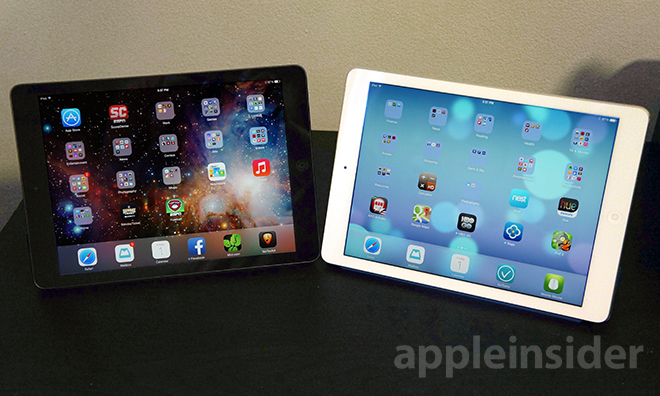
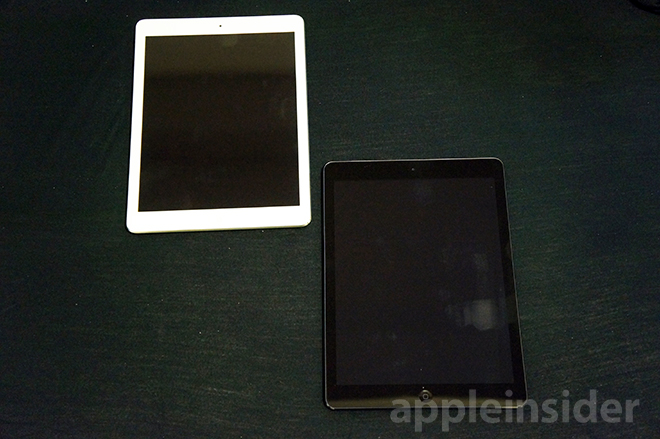
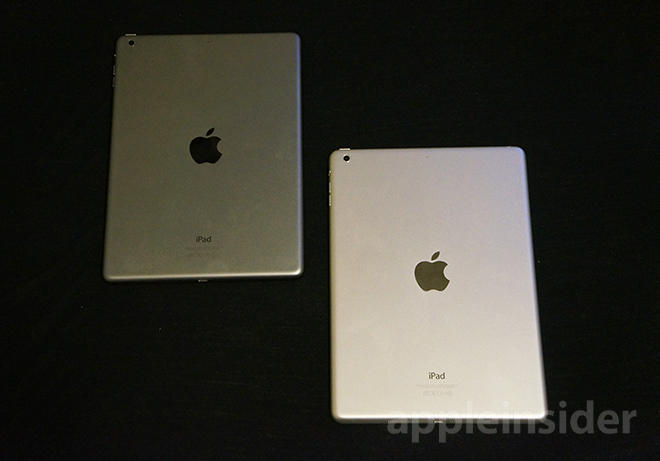
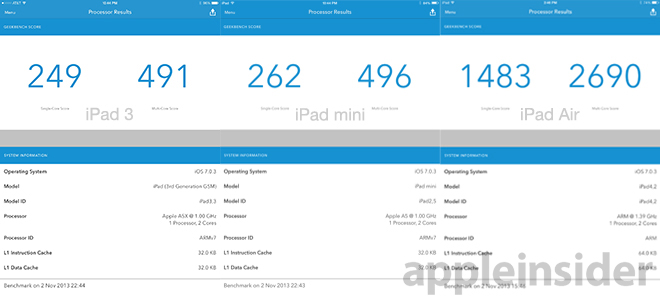
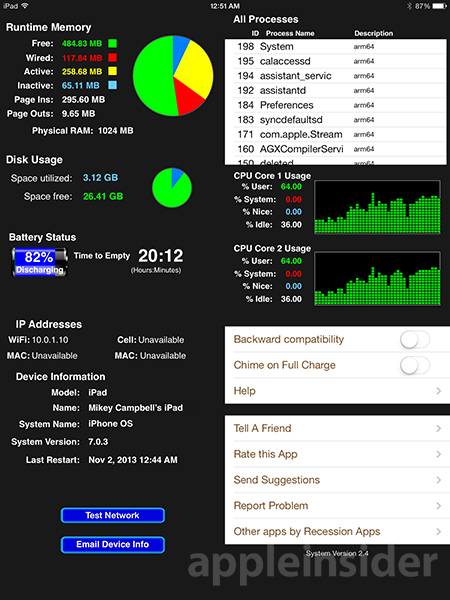



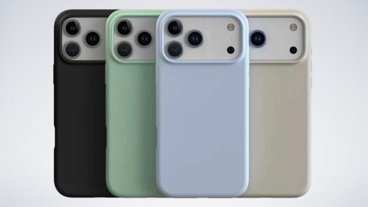




-m.jpg)






 Chip Loder
Chip Loder
 Marko Zivkovic
Marko Zivkovic
 Malcolm Owen
Malcolm Owen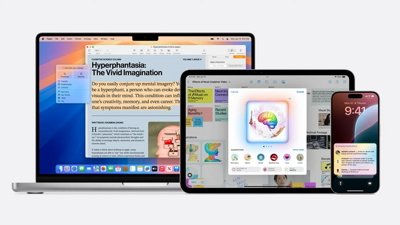

 William Gallagher
William Gallagher
 Christine McKee
Christine McKee
 Andrew O'Hara
Andrew O'Hara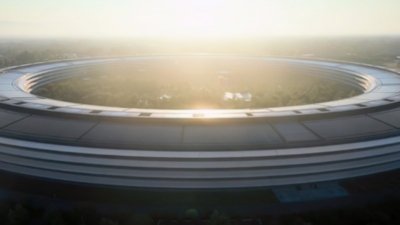
 Andrew Orr
Andrew Orr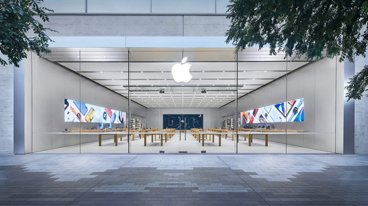




-m.jpg)




169 Comments
The iPad 6 (Air 2) is
Touch ID
A8
You'll need an excuse not to buy it.
Saying that you have to hold it in your hands to really understand is totally true. It's just crazy.
In the few days that I've my iPad Air I've already grown to love it. It's thinner, smaller, (way) lighter, faster -- I mean, what more could you ask for?
I'd give this 6 out of 5 stars. :)
When people say that you have to pick one of these up to believe it, they are not kidding. I got mine on launch day (32 GB WiFi white) and it's like picking up an iPad for the very first time. Some say that the biggest jump fpr this line, was from gen 1 to gen 2. I personally believe that the Air is as big a jump in improvement. Oh and the battery life on this thing is just amazing. My old third gen, given to my mom so she can Face time me from Europe, feels like one of those old gas guzzlers.
Love my new Air, i got the 64g wifi. The speed bump from the ipad3 is just incredible. I got the smart case, my new air with the case is lighter than my old ipad3 without a case. Btw i just sold my ipad3 32g 4g for $350, reducing the cost of the upgrade. A few benchmark: Basemark X on screen score: 13.32 fps Basemark X offscreen score: 15.52 fps GFXbench 2.7 T-REX HD off screen : 1488 (27 fps) GFXbench 2.7 T-REX HD on screen : 1152 (21 fps) GFXbench 2.7 Egypt HD off screen : 7164 (63 fps) GFXbench 2.7 Egypt HD on screen : 5507 (49 fps) I wish that Egypt HD test could be a real game, looks so nice.
[quote name="Ireland" url="/t/160548/review-apples-fifth-generation-ipad-air/0_100#post_2429603"]The iPad 6 (Air 2) is [COLOR=000000]seriously [/COLOR]going to kill: [COLOR=000000]Improved display[/COLOR] [COLOR=000000]8[/COLOR][COLOR=000000]MP camera[/COLOR] [COLOR=000000]802.11ac[/COLOR] Touch ID A8 You'll need an excuse [I]not[/I] to buy it. [/quote] Looks like performance is the bomb and the weight drop is desireable (especially coupled with the change to the rounded corners). I'm still really disappointed that the touch Id was not included in the ipad air or iPad mini... I don't know why... But I am. Although the cameras could use a better bump, I wasn't too surprised/disappointed in that... And why no AC wifi? Not quite compelling enough yet to upgrade from ipad3. Getting close though. I hate waiting...